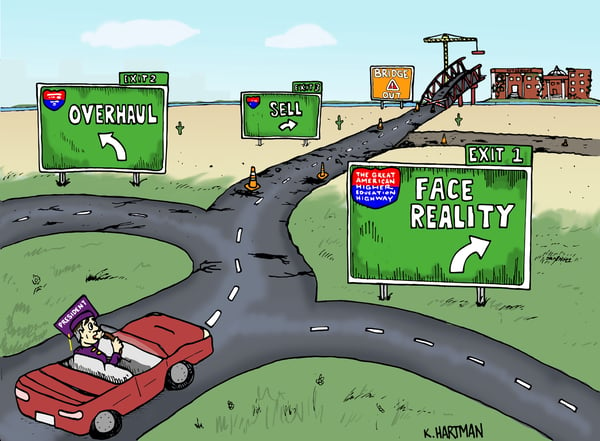Published on
The Exit Ramps That Could Save Higher Education

The following interview is with Ken Hartman, senior fellow and principal analyst at Eduventures and former president of Drexel University Online. Hartman is a leading advocate for transformation in the postsecondary space and recently shared his insights on the “exit ramp” concept at the 2014 Eduventures Annual Conference. In this interview, he expands on the concept and discusses what the future may hold for higher education institutions.
1. What is the “exit ramp” concept?
The basic premise is that American higher education is like a highway. For the past 50 years or so, the highway has been pretty predictable with occasional peaks or lulls; however, today, the highway looks very different with colleges facing historical changes both within and outside the academy, like higher enrollment, declined employment, record student debt, a lackluster economy (both here and abroad) and global unrest.
When the CFO from Harvard [University] states that their business model is unsustainable — and at the last count, they had a $33 billion endowment — it’s time for all colleges to examine where they are on the highway and seek the next exit because, for many, the bridge is out at the end of the road.
2. In the exit ramp concept, you lay out three exits: the first is just being honest with one’s staff and one’s school and ensuring that the rest of the institution understands the dire straits the institution is in and allowing them to move forward. Could you run through what the other two exit ramps are?
The first step is the easy stuff. It’s being honest with your stakeholders that things have to change, we have to do a better job in delivering the existing product that we have, we have to do a better job with retention, with student services, we have to look for ways of offering our degrees in a better, less expensive way.
The second exit becomes more difficult because you have to explain to your constituents why you flew right by the first exit. I’m asking about truly looking at what it is we’re offering and providing the return that the student is looking for in that type of investment. It becomes much harder because you’re looking at new ways to scale programs but not scale expenses. You’re also looking for partnerships in exit two, with outside vendors and other institutions.
The third exit, that’s the most difficult one. You’ve tried some of the things in exit one or two or, quite frankly, you’ve flown right by exit two or exit one and you don’t want to tell the truth to your constituents because you think that’s going to hurt you with your next job.
That gets into things such as mergers and acquisitions. You’re going to see states actually selling their institutions to the private sector. Take a look at other similar models where states have sold parks, bridges, prisons and roads. You don’t necessarily want to get to exit three; you really want to get off the road before. That’s why I’m encouraging institutions to use exit one, but you’ve got to start with honesty and truthfulness with your stakeholders.
3. Why do administrators so often fly past the first exit ramp?
In truth, a lot of senior administrators are more concerned about their next job than they are about their existing job. Many of them think they know the problems, but they think that somehow they’re going to be out of there and onto something bigger and better and less aggressive [by the time the big issues rise to the surface].
There’s no place to hide any longer. We’ve seen an unprecedented number of no-confidence votes. It takes a leader to stand up and say to their constituents, “Look, the road we’re on right now is not where we need to be. We have to get off this and if you’re willing to shoot me because I’m the messenger, then fire away, but I’m going to tell you the truth.” Again, that’s not going to help you get to your next job.
4. In the keynote you delivered at the Eduventures Annual Conference, you mentioned that student expectations have transformed drastically over the past 10 years. What do institutions need to do to meet the needs of the modern (and future) student?
It can be summed up very simply: focus on a higher-quality, lower-cost product. When we talk about higher quality, we’re talking about greater engagement that pays equal attention to outputs as well as inputs. We do a great job in creating syllabuses and worrying about what we’re putting into the course. We should be looking at what is coming out of the course, what some people now refer to as competencies..
5. These ideas paint a relatively dark picture for the state of higher education today. How do you think the postsecondary marketplace will look in 10 years’ time?
I’m amazingly optimistic about the future. Yes, the system needs to reset itself, but when it does, technology we currently have now and that will be developed in the future will help us create that more meaningful degree. The leaders down the road are going to be the ones that understand that now and begin to put the pieces in place because, ultimately, at the end of the day, that’s what people are going to be looking for. We’ve gotten ourselves into [a] what-the-consumer-wants attitude, when in fact what the consumer wants is a good educational experience.
6. Is there anything you’d like to add about the “exit ramp” concept and how it can help higher ed institutions rethink the way they do things to ensure they’re ready for higher education’s next era?
It all starts with an open and honest discussion. [Institutions need] to now have the conversation internally about building a life raft. My grandmother, who was a Holocaust survivor, used to say you plan for the worst, you pray for the best. That’s what we’re trying to do, planning and planning. You may not need to use that life raft, you may not need to get off that exit, but if you do you’re prepared for that.
This interview has been edited for length.
Author Perspective: Analyst



